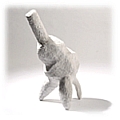Rauchskulpturen
Das Räuchern hat eine lange Geschichte, die mit den Ritualen des Menschen in enger Verbindung steht. „Per fumus“ bedeutet so viel wie „durch Rauch“ und von diesem Wort kommt das Wort Parfum. Duft wurde also mit Rauch in Verbindung gebracht. Noch heute wird in zahlreichen Kulturen geräuchert und das nicht nur im sakralen Bereich, sondern auch im Profanen. Das Thema Rauch und Objekt ist ein sehr sinnliches und ästhetisches, es vereint das materielle, die Skulptur und das und Immaterielle, den Rauch.
Der Rauch gehört zur Geschichte des Menschen, er ist, seit das Feuer von ihm nutzbar gemacht wurde, sein Begleiter. Inspiriert wurde Sonja Keppler zu ihrer Arbeit von der Recherche zu Rauchgefäßen in griechischen Museen, sowie auf einer Reise und Erzgebirge, wo es die berühmte Räuchermännchen-Tradition gibt. So übersetzt Sonja Keppler sehr urwüchsige, oft anthropomorphe oder tierische Formen, die es in der Geschichte der Gestaltung von Räuchergefäßen gibt, in freie, davon losgelöste Formen. Die Form der Räuchergefäße steht eng mit dem Menschen und der Natur in Verbindung. Es wurden Skulpturen geschaffen, die der Natur nahe kommen, organisch in ihrer Form und ihrer Struktur.
Mit den Skulpturen kann man etwas tun, sie stehen nicht nur, sondern sind auf neue Art und Weise erlebbar mit allen Sinnen. Die Gebilde werden ganz intuitiv gefertigt, geformt und scheinen zu kommunizieren, zu leben.
Das Thema Feuer spielt bei der Wahl der Materialien eine Rolle. Keramik und Bronze sind Materialien, die eine lange Geschichte in der Gestaltung von Räuchergefäßen haben. Verwendete Materialien der ausgestellten Exponate sind daher verschiedene Keramikarten, Bronze und Beton. Bei diesen Arbeiten verschwimmen die Grenzen zwischen Design und Kunst. Sie scheinen oft direkt aus der Erde zu stammen in ihrer archaischen Art.
Man kann in den Skulpturen Räucherkerzen abbrennen, oder direkt auf Räucherkohle frisches Räucherwerk verbrennen.
smokesculptures
Burning herbs and resin has a long history that is closely linked to human rituals. „Per fumus“ means something like „through smoke“ and this is the word from which the word perfume comes. Fragrance was also associated with smoke. Even today, incense burning is still practiced in many cultures, not only in sacred areas but also in profane areas. The topic of smoke and objects is a very sensual and aesthetic one, it combines the material, the sculpture, and the immaterial, the smoke.
Smoke is part of human history, it has been our companion ever since we made fire usable. Sonja Keppler was inspired to work by researching incense burners in Greek museums, as well as on a trip to the Ore Mountains, where the famous incense smoker tradition exists. Sonja Keppler translates very primitive, often anthropomorphic or animal forms that exist in the history of incense burner design into free, detached forms. The shape of the incense burners is closely linked to people and nature. Sculptures were created that are close to nature, organic in their shape and structure.
You can do something with the sculptures; they don’t just stand, they can be experienced in a new art and way with all the senses. The objects are made and shaped very intuitively and seem to communicate, to live.
The theme of fire plays a role in the choice of materials. Ceramics and bronze are materials that have a long history in the design of incense burners. In these work, the boundaries between design and art are blurred. They often seem to come straight from the earth in their archaic art.
You can burn incense candles in the sculptures, or burn fresh incense directly on charcoal.

